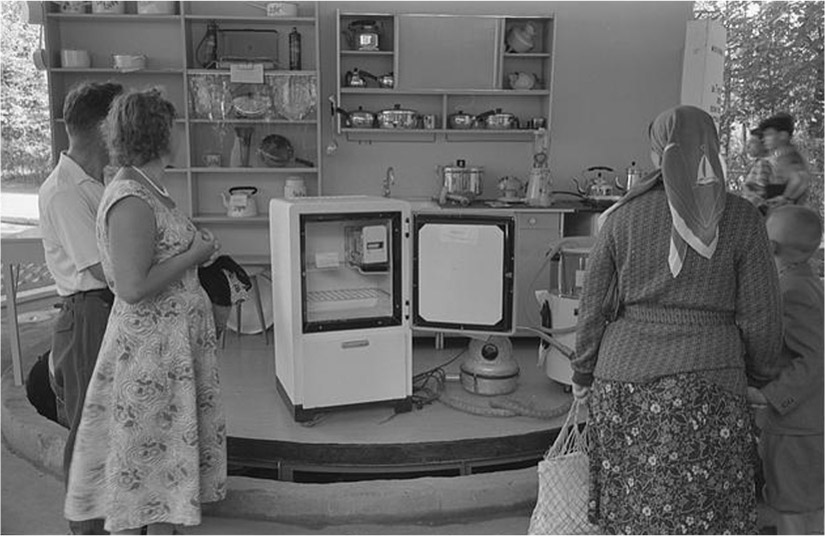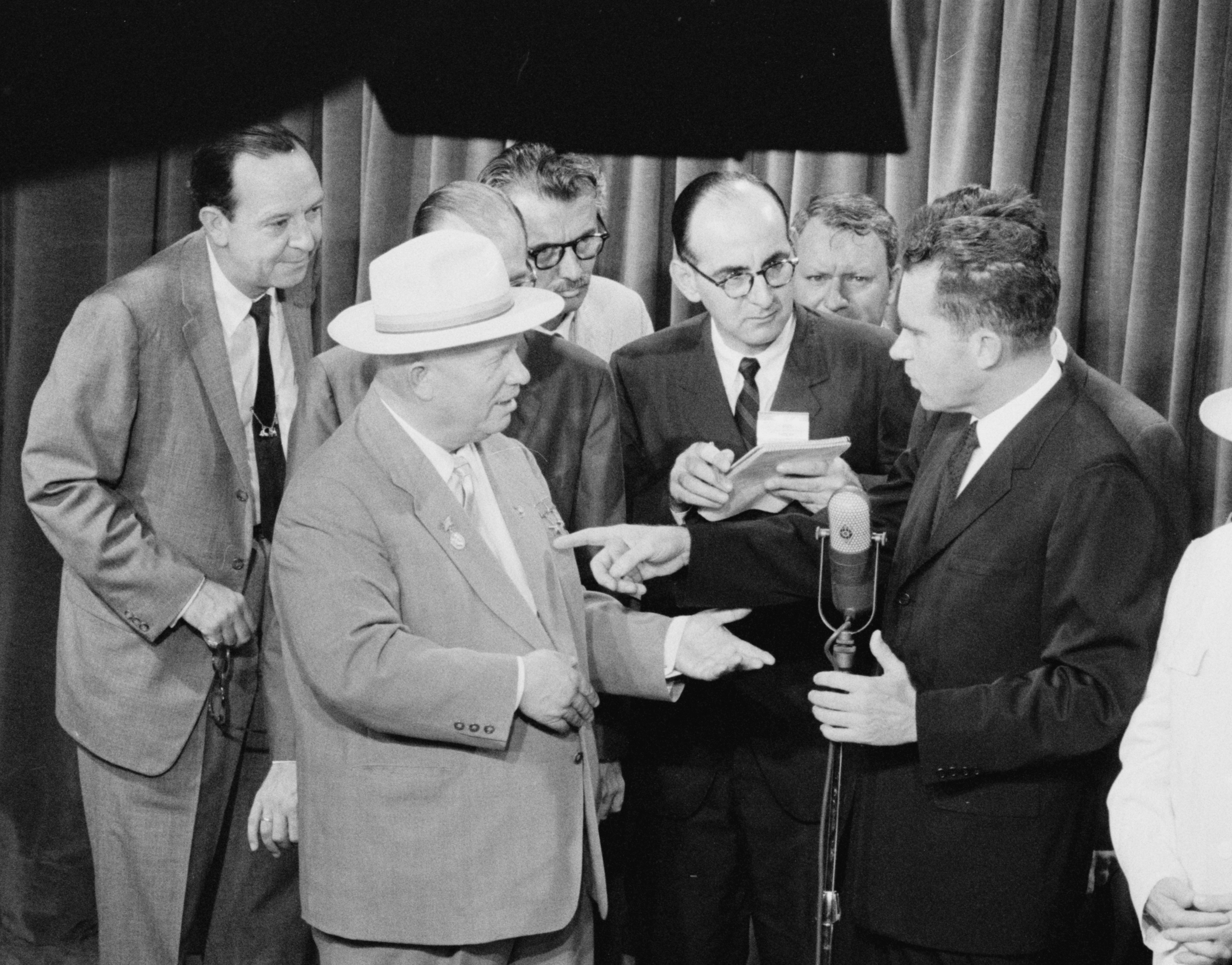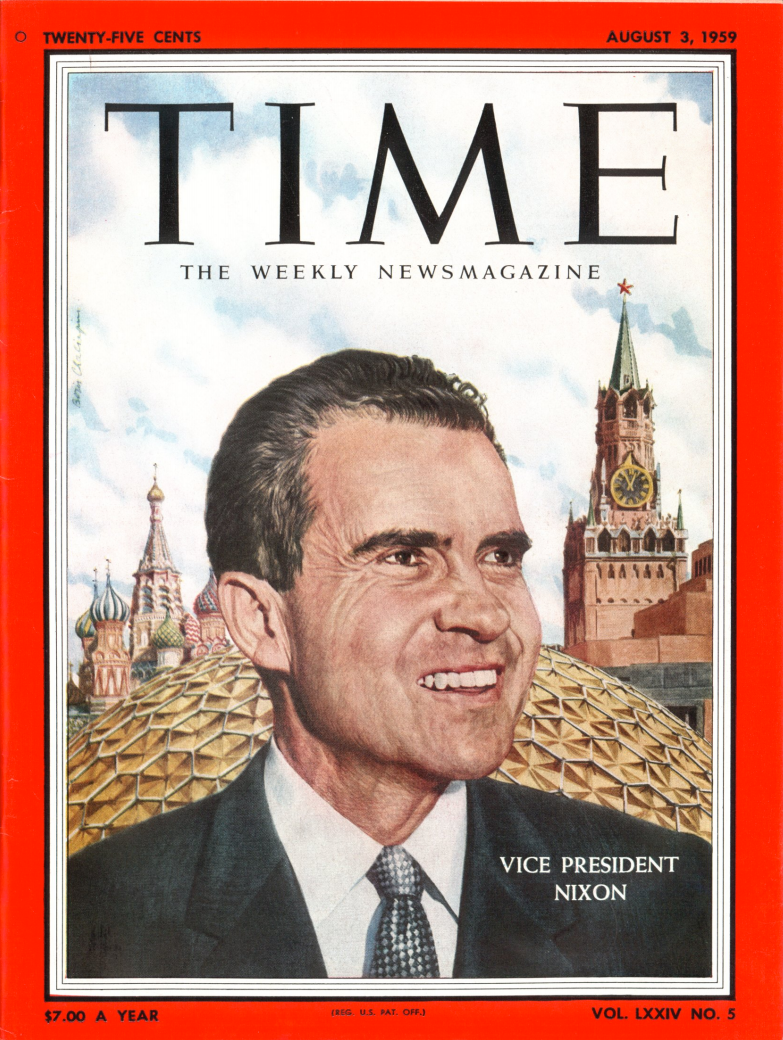
Kitchen Debate: 'Peacetime dimplomacy's most amazing 24 hours' with Nixon and Khruschev
In 1952, California Sen. Richard Nixon saved his political career by making a televised plea directly to America to help explain away accusations of a political slush fund. “The Checkers speech” preserved his spot on Dwight Eisenhower’s presidential election ticket.
Seven years later, with Nixon still a year away from running for the presidency himself, he visited an exhibition of American household technology for the citizens of Moscow and held an impromptu debate with Soviet Premier Nikita Khrushchev on July 24, 1959 — 65 years ago Wednesday.
The American National Exhibition in Moscow
In an effort to promote understanding of each other’s countries in the thick of the Cold War, the Soviet Union and the United States agreed to a cultural exchange of exhibits in 1959.
A Soviet exhibit opened in New York City in June of that year, featuring mostly industrial machinery and military technology. A month later, the American National Exhibition opened in Moscow’s Sokolniki Park. Each exhibit was open for six weeks and each attracted roughly 3 million visitors.
The U.S. exhibit featured a large geodesic dome that held a 30,000-square-foot science lab. The Soviets were more impressed with the dome than with the technological items on display there. When the exhibit closed, they bought the dome.

Credit: The bill of Rights Institute. Soviet citizens tour the American exhibit at Sokolinki Park, Moscow, in 1959.
All sorts of things were sent to Moscow for the exhibition: computers, farm tractors, a multiscreen movie and a typical suburban home with the side cut away so guests could see inside. The exhibit was sponsored by companies like IBM, Sears, RCA, Kodak, Pepsi-Cola and Dixie Cup Co.
Perhaps the most popular spot in the American exhibit was a demonstration kitchen, sponsored by Macy’s, outfitted with sleek, modern appliances like a washing machine, a lemon juicer and a food processor.
President Dwight D. Eisenhower sent his vice president, Richard Nixon, and his brother, Milton — the president of Johns Hopkins University — to Moscow for the opening of the exhibit.
The Kitchen Debate
The U.S. exhibition opened on July 24, 1959. Nixon was on hand to give Soviet leader Nikita Khrushchev a tour of the exhibition. They were accompanied by newspaper writers, government officials and translators: Nixon didn’t speak Russian and Khrushchev didn’t speak English.
Things went off the rails early. Khrushchev adopted an sneering attitude toward most of the innovations, proclaiming that the Soviet Union would have the same sort of gadgets and appliances within a few years.
Nixon, trying to be a diplomatic host, said the Soviet leader should “not be afraid of ideas. After all, you don’t know everything.”
Khrushchev snapped back: “You don’t know anything about communism — except fear of it.”
“The way you dominate the conversation,” Nixon replied, “... if you were in the United States Senate you would be accused of filibustering.”
Nixon showed off a food processor. Khrushchev was unimpressed. “Don’t you have a machine that puts food in your mouth and pushes it down?” he asked.

Khrushchev and Nixon trade insults during the Kitchen Debate on July 24, 1959. Credit to Library of Congress.
William Safire — who’d later become an advisor and speechwriter for Nixon after his election in 1968 — wrote in the New York Times that he was present at what came to be called the Kitchen Debate.
“I was in that kitchen,” he wrote, “not because I then had anything to do with Nixon, the exhibition’s official host, but as a young press agent for the American company that built the house.”
Nixon continued his tour, explaining that a home like the one in the exhibition could be bought for $14,000 and a government-guaranteed veteran’s mortgage could place it within reach of a steelworker making $3 and hour.
“We have peasants who also can afford to spend $14,000 for a house,” Khrushchev snarked.
In frustration, Nixon finally asked his guest: “Would it not be better to compete in the relative merit of washing machines than in the strength of rockets?
“In this day and age to argue who is stronger completely misses the point.” Nixon continued. “With modern weapons it just does not make sense. If war comes we both lose.”
At the end of the visit, Nixon and Khrushchev agreed that the video of the tour — and their running debate — would be broadcast in both countries. It was aired in the U.S. the next day, earning Nixon much respect for appearing to stand up to the foul-tempered Khrushchev. In the Soviet Union, the video was shown only once, very late at night and with Nixon’s dialogue only partially translated.
That evening, Safire was attending a reception in which he was introduced to a gleeful Nixon, who told him: “We really put your kitchen on the map, didn’t we?”
Reaction to the Debate
The Kitchen Debate was front-page news across the U.S. Frank Stanton, president of CBS, wrote Nixon to tell him the TV special featuring the incident was viewed by 15 million households, or 41.7% of all homes with TV sets. That night, Nixon had beaten “Gunsmoke.”
Eisenhower sent his vice president a note praising his work in Moscow. Nixon had faced many challenges, Ike said, and had handled them well.
The New York Times dismissed Nixon’s actions at the exhibit as little more than a political stunt. But others were impressed. Time magazine described opening day at the American National Exhibition as “peacetime diplomacy’s most amazing 24 hours.”

“Nixon was getting through to the Russian people with a message that told of a man, a system, and a country dedicated not to war, as Communist propaganda had insisted, but to prosperity and peace,” Time reported.
Historian John E. Moser of Ashland University writes that “the debate demonstrated that the Cold War had moved into a new phase, one characterized less by the threat of looming military conflict between the United States and the Soviet Union, and more by a contest to win over the people of the developing world.”
For his part, Nixon recommended to Eisenhower that he invite Khrushchev for a visit to the United States. Khrushchev spent 13 days in September of that year, visiting Washington, D.C., New York, farms in Iowa and Maryland and Los Angeles.
Khrushchev was hugely disappointed, however, when he was told that, for security reasons, he would not be allowed to visit the single place he wanted most to see: Disneyland.
During his presidential campaign the next year, Nixon suffered a disastrous televised debate performance against Democratic opponent John F. Kennedy in September 1960. Kennedy won the popular vote by only 112,827 votes.
Nixon would have to wait until 1968 to earn a presidential administration of his own.